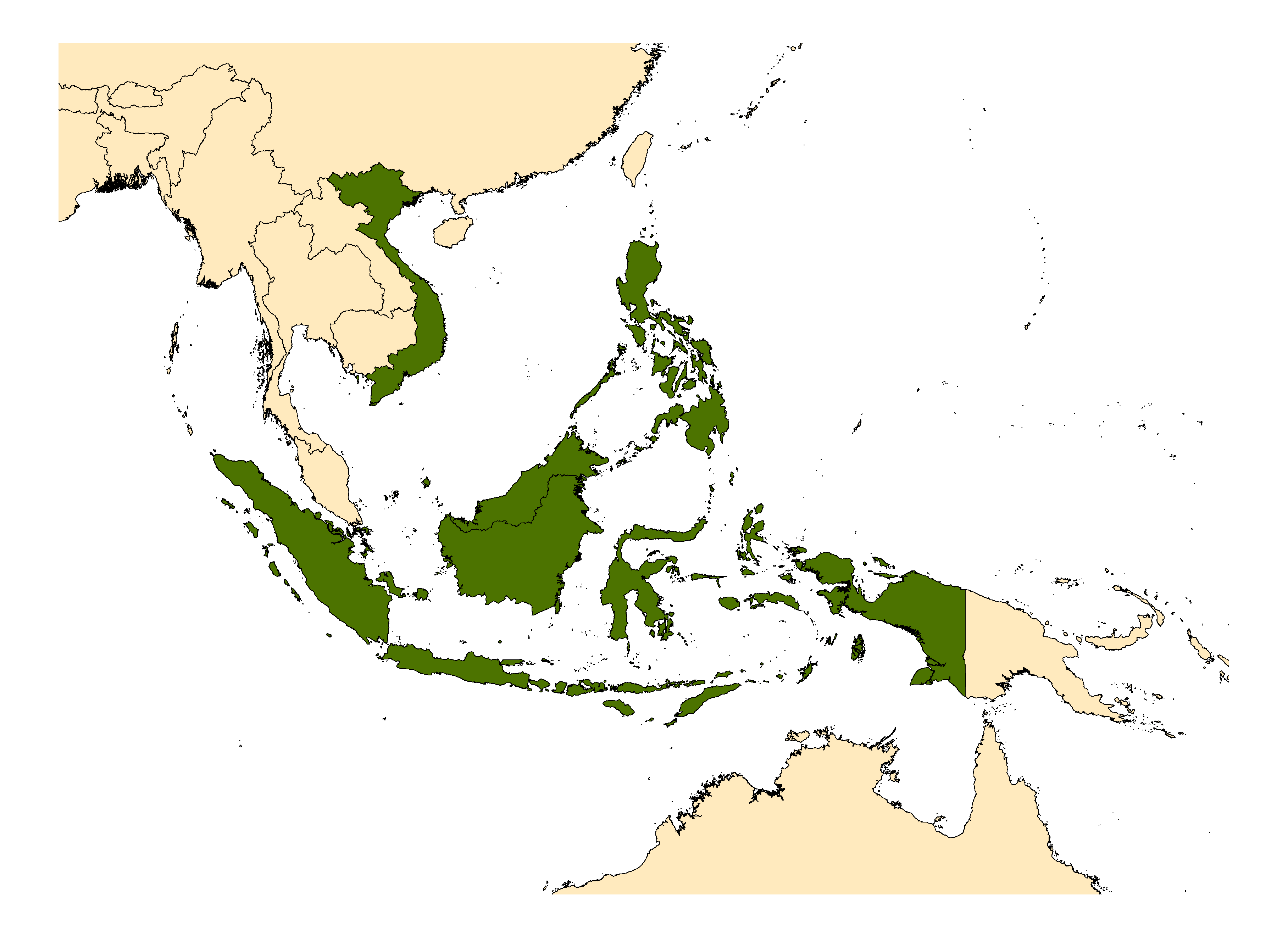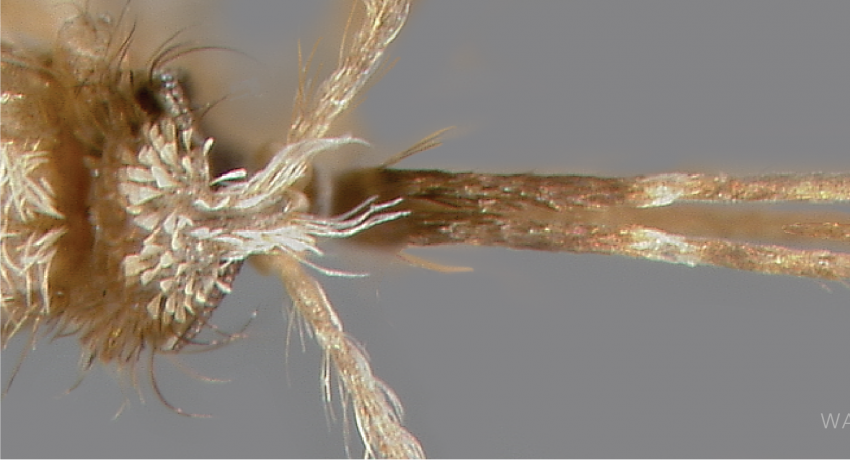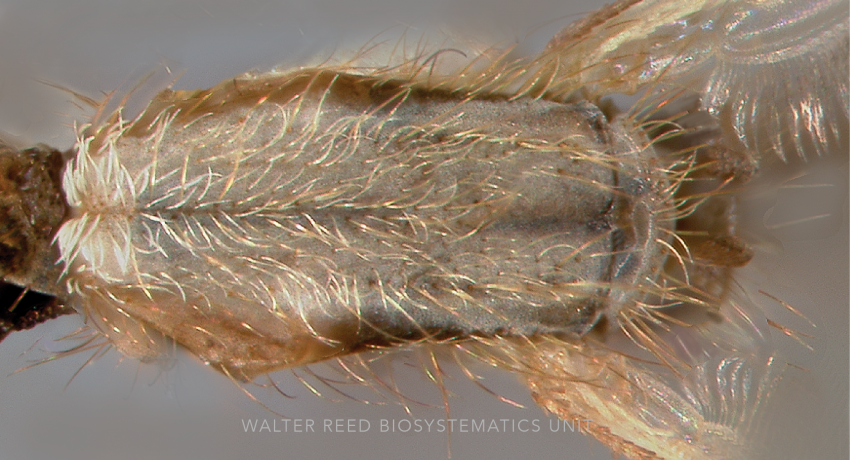ORIENTAL REGION
Etymology: yellow beak (L); proboscis
The tiny species An. flavirostris is recognized by three distinct pale bands and a yellow tip to its proboscis, and three large pale spots on the leading edge of its wing. Morphologically, An. flavirostris is very close to An. minimus Theobald. It was long regarded as a subspecies of An. minimus until DNA and hybridization studies, along with differences in the cibarial armature, confirmed the separate species status of these taxa. The two species have been routinely misidentified, leading to confusion in assigning bionomic traits and vector competency. All historical records of An. minimus from the Philippines, Indonesia and eastern Borneo are now attributed to An. flavirostris. Anopheles flavirostris belongs to the Minimus Subgroup, along with together with An. leesoni Evans, and An. longipalpis (Theobald).
Type locality: Camp Wilhelm, Tayabas [=Quezon], [Luzon], Philippines
Type depository: U.S. National Museum, Washington, D.C., United States (USNM)
DIAGNOSTIC CHARACTERS (Click photos to view; mouse over and click large photo to zoom in.)
ADULT (illustrated): Head: Proboscis with ventral pale scale patch; palpus with 3 pale bands; MPlp5 pale basally. Thorax: Antepronotum without scales; proepisternum with 1–4 setae. Thorax: Center of scutum pale, setose, mostly lacking scales. Wing: With relatively few dark spots; ≤3 dark spots on CuA and vein 1A; fringe without pale spot at end of vein 1A; base of vein R with white or yellow-white scales. Legs: Entirely dark-scaled.
LARVA (not illustrated): Head: Seta 1-A single, small; seta 2-C single, inserted ≥ the distance between 2-C and 3-C on one side. Thorax: Seta 3-T palmate, leaflets without long fine points. Abdominal segments: Seta 0-IV–VI arising just posterolateral to tergal plate, or just on or at edge of plate; seta 0-IV–VII small, 1-2 branched; tergal plates on III–VII very large, ≥0.5 width of segment, enclosing small median posterior accessory plate; tergal plates rounded posteriorly.
TAXONOMIC KEYS
Cagampang-Ramos & Darsie 1970
Harrison 1980
Lee et al. 1987b
Becker et al. 2010
![]()
WRBU – Anopheles - Myzomyia Series - Indomalayan Region - Larva
![]()
WRBU - Genera - Global - Adult
![]()
WRBU - Genera - Global - Larva
![]()
WRBU - Genera - Indomalaya - Adult
![]()
WRBU - Genera - Indomalaya - Larva
![]()
WRBU - Anopheles Subgenera and Series - Indomalaya - Adult
![]()
WRBU - Anopheles Subgenera and Series - Indomalaya - Larva
Exemplar DNA sequences
An. flavirostris ITS2: AB088384, AY943666, GU062188, GQ500121
BIONOMICS
Immatures
Immatures are typically found in shaded portions of clear, slow-flowing sites—streams, canals, drainage ditches and seepage pools—with emergent vegetation, particularly those close to human habitation. They are never found in stagnant or saline waters.
Adults
Anopheles flavirostris is most closely associated with lowland foothills, but specimens have been collected from sea level up to 1,500m. Large mammals including buffalos, cows and people are the preferred hosts of An. flavirostris, and biting occurs throughout the night, peaking towards midnight. In eastern Borneo (Sabah & East Kalimantan), An. flavirostris is highly anthropophilic, and will enter houses to feed, whereas, in other islands of the Indonesian archipelago, it is rarely collected at human bait, is predominantly exophilic, and is only regarded as a secondary vector. In the Philippines, the species serves as a low-level maintenance vector of malaria.
DISTRIBUTION NOTES
Indonesia (includes E. Kalimantan, Sumatra Java, Sulawesi, Bali, Lombok, Sumbawa, Sumba, Flores, West Timor), Philippines, Timor, Vietnam.

WRBU VECTOR HAZARD REPORTS
View other WRBU Vector Hazard Reports
Available GIS Models
IMPORTANT REFERENCES (full citations below)
Ludlow 1914a: 30 (F; Myzomyia; as sp.)
King 1932b: 491 (M*, F*, L*; to species)
Baisas 1936a: 215 (P*)
Baisas 1947b (1st instar L; as minimus subspecies flavirostris)
Gapuz & Santiago 1949: 127 (L*)
Mendoza & Abinoja 1952: 53 (bionomics)
Bonne-Wepster & Swellengrebel 1953: 371 (M*, F*, L*)
Stone & Knight 1956b: 277 (type information, lectotype designation)
Baisas 1957: 68 (to species)
Basio 1971b: 43 (M*, F*; bionomics; as minimus subspecies)
Cagampang-Ramos & Darsie 1970 (F*, L*; keys)
Pinhão 1974 (distribution; Timor)
Baisas 1974: 59 (M, F*, P, L*, E*; taxonomy, bionomics, distribution; Philippines)
Harrison 1980 (F, L, P; keys, taxonomy, review)
Lee et al. 1987b: 196 (F key, taxonomy, review)
Somboon et al. 2000: 476 (support of species)
Whelan & Hapgood 2000 (bionomics, distribution; East Timor)
Foley et al. 2002 (bionomics)
Foley et al. 2003 (bionomics)
Torres et al. 2006 (molecular taxonomy)
Foley & Torres 2006 (population genetics)
Becker et al. 2010: 343 (F*, L*; key, taxonomy, distribution, bionomics)
Sinka et al. 2011: 89 (bionomics review, distribution, niche model)
Sinka et al. 2011 (bionomics, review, niche model; Asia-Pacific Region)
CURRENT SYNONYMS
syn. merak (cohesia) Mangkoewinoto
1919: 57 (A, L*; Myzomyia aconita variety). Type locality: Kali Madaksa in Merak (Bantam) West Java (NE). References: Harrison 1980: 40 (synonymy, transfer from minimus).
CITED REFERENCES
Baisas, F. E. (1936a). Notes of Philippine mosquitoes, VI. The pupal characters on anophelines of the subgenus Myzomyia. Philippine Journal of Science, 61(2), 205–245.
Baisas, F. E. (1947b). Notes on Philippine mosquitoes. XIV. The larval instars of Anopheles. Monthly Bulletin of the Bureau of Health, 23(3), 197–207.
Baisas, F. E. (1957). Notes on Philippine mosquitoes. XVIII. The malaria vector, flavirostris: summary of recent findings. Bulletin of the Department of Health, 29(2), 68–90.
Baisas, F. E. (1974). The mosquito fauna of Subic Bay Naval Reservation, Republic of the Philippines. San Francisco: Headquarters, First Medical Service Wing (PACAF), San Francisco.
Basio, R. G. (1971b). The mosquito fauna of the Philippines (Diptera, Culicidae). Manila: National Museum of the Philippines. 198pp.
Becker, N., Petrić, D., Zgomba, M., Boase, C., Madon, M., Dahl, C., & Kaiser, A. (2010). Mosquitoes and their control (Second ed.). Berlin Heidelberg: Springer-Verlag.
Bonne-Wepster, J., & Swellengrebel, N.H. (1953). The anopheline mosquitoes of the Indo-Australian Region. Amsterdam: J. H. de Bussy.
Cagampang-Ramos, A., & Darsie Jr., R.F. (1970). Illustrated keys to the Anopheles mosquitoes of the Philippine Islands. US Air Force 5TH Epidemiology Flight, PACAF, Technical Report, 1–49.
Foley, D.H., & Torres, E.P. (2006). Population structure of an island malaria vector. Medical and Veterinary Entomology, 20(4), 393–401.
Foley, D.H., Torres, E.P., & Mueller, I. (2002). Stream-bank shade and larval distribution of the Philippine malaria vector Anopheles flavirostris. Medical and Veterinary Entomology, 16(4), 347–355.
Foley, D.H., Torres, EP., Mueller, I., Bryan, J.H., & Bell, D. (2003). Host-dependent Anopheles flavirostris larval distribution reinforces the risk of malaria near water. Transactions of the Royal Society of Tropical Medicine and Hygiene, 97(3), 283–287.
Gapuz, R.B., & Santiago, D. (1949). A supplementary guide for rapid identification of larvae of Anopheles minimus flavirostris (Ludlow) and Anopheles mangyanus (Banks). Philippine Journal of Science, 78, 127–133.
Harrison, B.A. (1980). Medical entomology studies - XIII. The Myzomyia Series of Anopheles (Cellia) in Thailand, with emphasis on intra-interspecific variations (Diptera: Culicidae). Contributions of the American Entomological Institute, 17(4), 1–195.
King, W.V. (1932b). Three Philippine Anopheles of the funestus-minimus subgroup. Philippine Journal of Science, 48, 485–523.
Lee, D.J., Hicks, M.M., Griffiths, M., Debenham, M.L., Bryan, J.H., Russell, R.C., . . . Marks, E.N. (1987b). The Culicidae of the Australasian region. Volume 5. Commonwealth Department of Health, School of Public Health and Tropical Medicine Monograph Series, 2.
Ludlow, C.S. (1914a). Philippine mosquitoes. Psyche, 21, 30–32.
Mangkoewinoto, R.M.M. (1919). Anophelinen van West-Java. Mededellingen van den Burgerlijken Geneeskundigen Dienst in Nederlandsch-Indie, 8, 41–82.
Mendoza, J.B. & Abinoja, B. (1952). Observation on supposedly unusual breeding of the Philippine malaria vector Anopheles minimus flavirostris. The Philippine Journal of Science, 53.
Pinhão, Rui da Costa (1974). Sôbre a situação zoogeográfica de Timor. Anais do Instituto de Hygiene e Medicina Tropical, 1(1–4), 467–470.
Sinka, M.E., Bangs, M.J., Manguin, S., Chareonviriyaphap, T., Patil, A.P., Temperley, W.H., ... Hay, S.I. (2011). The dominant Anopheles vectors of human malaria in the Asia-Pacific region: Occurrence data, distribution maps and bionomic précis. Parasites & Vectors, 4(1), 89.
Somboon, P., Tuno, N., Tsuda, Y., & Takagi, M. (2000). Evidence of the specific status of Anopheles flavirostris (Diptera: Culicidae). Journal of Medical Entomology, 37(3), 476–479.
Stone, A., & Knight, K.L. (1956b). Type specimens of mosquitoes in the United States National Museum. III. The genera Anopheles and Chagasia (Diptera, Culicidae). Journal of the Washington Academy of Sciences, 46(9), 276–280.
Torres, E.P., Foley, D H., & Bryan, J.H. (2006). Molecular systematics of the Philippine malaria vector Anopheles flavirostris. Medical and Veterinary Entomology, 20(1), 44–52.
Whelan, P., & Hapgood, G. (2000). A mosquito survey of Dili, East Timor, and implications for disease control. Arbovirus Research in Australia, 8, 405–416.
CITE THIS PAGE
Walter Reed Biosystematics Unit (Year). Anopheles flavirostris species page. Walter Reed Biosystematics Unit Website, http://wrbu.si.edu/vectorspecies/mosquitoes/flavirostris, accessed on [date (e.g. 03 February 2020) when you last viewed the site].











































































































































































